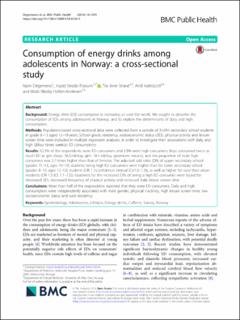| dc.contributor.author | Degirmenci, Naim | |
| dc.contributor.author | Fossum, Ingrid Nesdal | |
| dc.contributor.author | Strand, Tor A | |
| dc.contributor.author | Vaktskjold, Arild | |
| dc.contributor.author | Holten-Andersen, Mads Nikolaj | |
| dc.date.accessioned | 2020-09-04T11:41:05Z | |
| dc.date.available | 2020-09-04T11:41:05Z | |
| dc.date.created | 2018-12-20T13:04:54Z | |
| dc.date.issued | 2018 | |
| dc.identifier.citation | BMC Public Health. 2018, 18 (1391), . | en_US |
| dc.identifier.issn | 1471-2458 | |
| dc.identifier.uri | https://hdl.handle.net/11250/2676435 | |
| dc.description.abstract | Background Energy drink (ED) consumption is increasing all over the world. We sought to describe the consumption of EDs among adolescents in Norway, and to explore the determinants of daily and high consumption. Methods Population-based cross-sectional data were collected from a sample of 31,091 secondary school students in grade 8–13 aged 12–19 years. School grade, residency, socioeconomic status (SES), physical activity and leisure screen time were included in multiple regression analyses, in order to investigate their associations with daily and high (≥four times weekly) ED consumption. Results 52.3% of the respondents were ED consumers and 3.5% were high consumers. Boys consumed twice as much ED as girls (boys: 36.3 ml/day, girls: 18.5 ml/day, geometric means), and the proportion of male high consumers was 3.7-times higher than that of females. The adjusted odd ratio (OR) of upper secondary school (grades 11–13, ages 15–19) students being high ED consumers were higher than for lower secondary school (grades 8–10, ages 12–15) students (OR 1.1(confidence interval (CI):1.0–1.3)), as well as higher for rural than urban residents (OR 1.3 (CI: 1.1–1.5)). Gradients for the increased ORs of being a high ED consumer were found for decreased SES, decreased frequency of physical activity and increased daily leisure screen time. Conclusions More than half of the respondents reported that they were ED consumers. Daily and high consumption were independently associated with male gender, physical inactivity, high leisure screen time, low socioeconomic status and rural residency. | en_US |
| dc.description.abstract | Consumption of energy drinks among adolescents in Norway: a cross-sectional study | en_US |
| dc.description.sponsorship | The study was based on data from a survey conducted by Norwegian Social
Research (NOVA), in collaboration with the seven regional drug and alcohol
competence centres (KoRus), and was financed by the Norwegian
Directorate of Health, the Ministry of Children, Equality and Social Inclusion
and the Ministry of Justice. Naim Degirmenci and Ingrid Nesdal Fossum were
funded through research grants upon application to the Innlandet Hospital
Trust. None of the funding bodies were involved in the design of the study,
collection, analyses or interpretation of the data or in the writing of the
manuscript. | en_US |
| dc.language.iso | eng | en_US |
| dc.rights | Navngivelse 4.0 Internasjonal | * |
| dc.rights.uri | http://creativecommons.org/licenses/by/4.0/deed.no | * |
| dc.subject | Adolescents; | en_US |
| dc.subject | Caffeine; | en_US |
| dc.subject | Energy drinks; | en_US |
| dc.subject | Epidemiology; | en_US |
| dc.subject | Lifestyle; | en_US |
| dc.subject | Norway; | en_US |
| dc.subject | Survey; | en_US |
| dc.title | Consumption of energy drinks among adolescents in Norway: a cross-sectional study | en_US |
| dc.type | Peer reviewed | en_US |
| dc.type | Journal article | en_US |
| dc.description.version | publishedVersion | en_US |
| dc.rights.holder | © The Author(s). 2018 Open Access This article is distributed under the terms of the Creative Commons Attribution 4.0
International License (http://creativecommons.org/licenses/by/4.0/), which permits unrestricted use, distribution, and
reproduction in any medium, provided you give appropriate credit to the original author(s) and the source, provide a link to
the Creative Commons license, and indicate if changes were made. The Creative Commons Public Domain Dedication waiver
(http://creativecommons.org/publicdomain/zero/1.0/) applies to the data made available in this article, unless otherwise stated. | en_US |
| dc.source.pagenumber | 9 | en_US |
| dc.source.volume | 18 | en_US |
| dc.source.journal | BMC Public Health | en_US |
| dc.source.issue | 1391 | en_US |
| dc.identifier.doi | 10.1186/s12889-018-6236-5 | |
| dc.identifier.cristin | 1646221 | |
| cristin.unitcode | 1991,6,3,0 | |
| cristin.unitcode | 1991,1,2,0 | |
| cristin.unitname | Avd Barn | |
| cristin.unitname | Avd Forskning | |
| cristin.ispublished | true | |
| cristin.fulltext | original | |
| cristin.qualitycode | 1 | |

